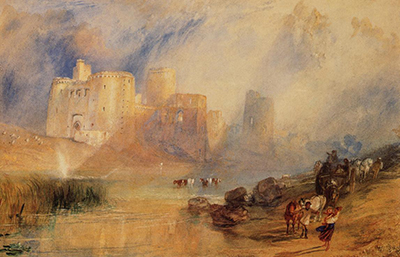Kidwelly Castle is entirely typical of JMW Turner, with expressive, emotional touches of the brush to form bright skies and powerful lighting. He himself was a huge fan of the British countryside and would produce many artworks based on its unique beauty.
This beautiful construction can still be found today in Kidwelly, Carmarthenshire, Wales. The artist travelled to this principality several times, becoming more ambitious each time. He quickly developed a love for this western region of the UK which is still famous today for his breaktaking scenery. The castle was initially constructed in the 12th century but later replaced with a stronger network of stone bricks. Today it is a popular tourist spot and has been well maintained inorder to keep it as faithful as possible to how it was centuries ago, just as the artist would have seen it himself. The location itself is known to be dramatic and this would have attracted the artist, who would always consider the area around a castle just as much as the building itself.
This painting is believed to have been made using watercolours, but the artist produced a lot of other works here. We have engraved prints which went into distribution at about the same time as well as a number of other paintings and drawings which captured the town itself, or the castle from alternative angles. We do know plenty about the artist's journeys to Wales, but individual artworks which came from these visits are not always as well documented. We find ourselves trying to piece together information from related artworks, with a line-engraved drawing found in the Royal Academy's collection being of most interest. Given the nature of that medium, the prints from engravings are entirely black and white, whilst this watercolour offers us so much more.
The castle itself sits at the back of the scene, raised on a hill, with its residents looking down on any potential dangers. Wild lighting sits behind the castle itself, some of which comes in diagonally from the top right of the canvas, down to the bottom left. In front of the mound on which the castle has been built, a river sweeps past in a relatively serene manner. The banks are displayed on both sides, with just a few reeds sticking out on the left, but more activity to be found across on the right. Several people and livestock can be found there. These elements closer to us are also given a darker, sharper detail to add a level of perspective, whilst the castle at the back is misty and romantically depicted.




